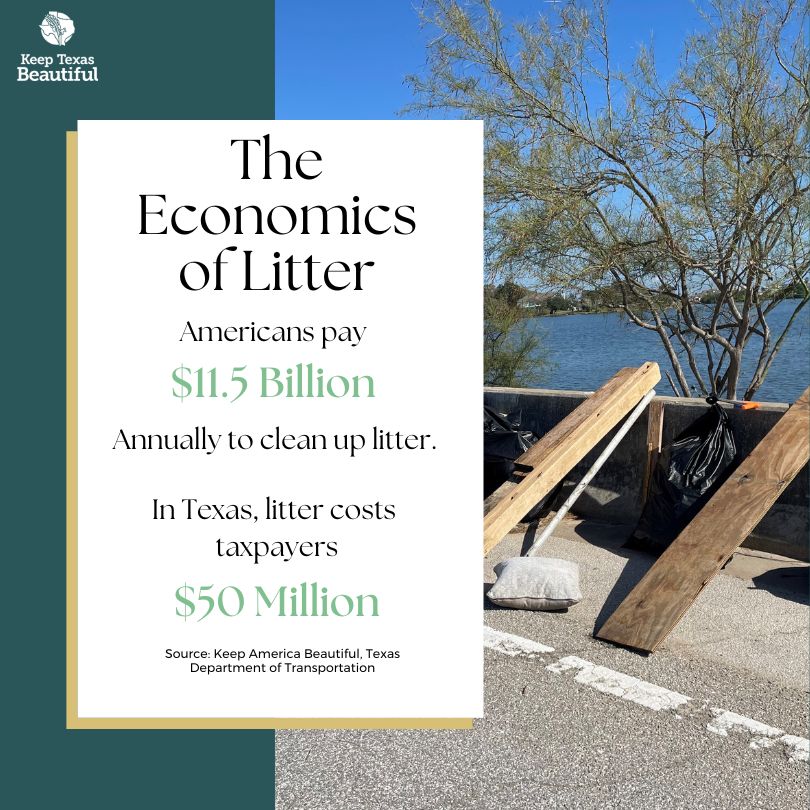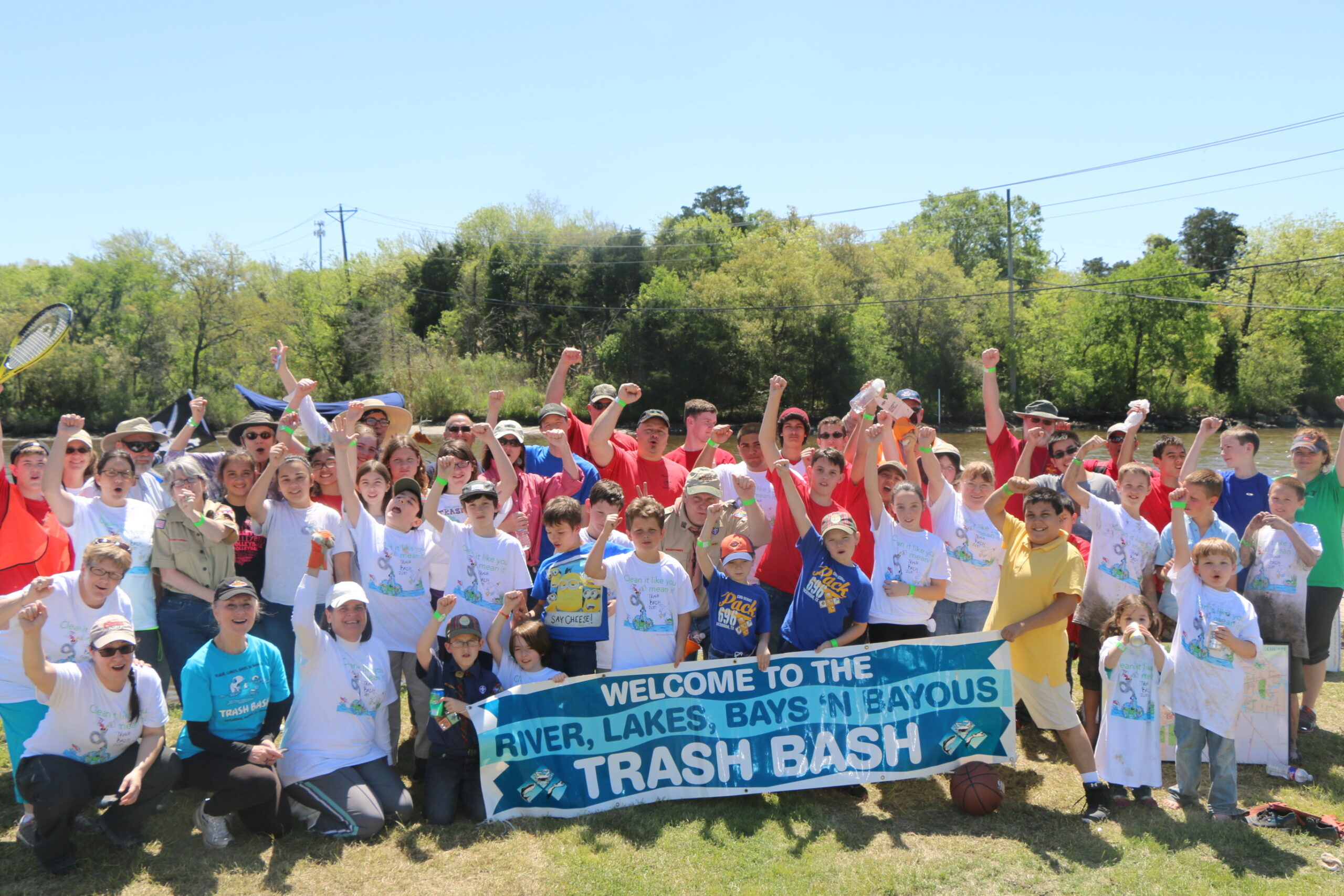The Economics of Litter
By Kirsten Sorensen, Research and Cleanups Program Manager and Lara George, Director of Marketing and Partnerships

Annual Cost of Litter Cleanup Efforts
Each year, Americans spend approximately $11.5 billion to remediate trash. Picking up trash is the most expensive way to deal with litter, according to a study published by Keep America Beautiful.
In Texas, taxpayers spend $50 million to pick up litter from Texas roadsides, in addition to private efforts from businesses, non-profit organizations, and volunteers.
Despite that investment, 90% of Americans feel that litter is a problem in their community.
Impacts to Tourism
Tourism is big business in Texas, responsible for $193.8 billion in economic activity. That includes direct, indirect, and induced spending from tourism.
However, tourism declines when areas are perceived as littered. A study published in Marine Policy indicated that 85% of beach tourists would avoid a heavily littered beach, and would travel instead to another state’s beach. They estimated the economic impact of this change in behavior could affect tourism spendng by 38.1%.


Infrastructure Impacts
Litter has significant negative impacts on infrastructure, leading to increased maintenance costs and reduced functionality of public spaces. Debris can clog drainage systems, causing blockages that lead to flooding, erosion, and damage to roads and sidewalks.
Accumulated litter in public spaces, such as parks and streets, detracts from their aesthetic value, potentially discouraging tourism and reducing community pride.
Moreover, cleaning up litter requires the diversion of public funds that could otherwise be invested in improving infrastructure. Persistent litter can also damage facilities like public transportation systems and utilities, contributing to faster deterioration and higher repair needs.
According to the American Society of Civil Engineers, Texas’s wastewater system has a $200 million deficit in infrastructure investments.
Public Health Costs
The cost of litter on public health is substantial, as it contributes to environmental contamination and poses direct risks to human well-being.
Accumulated trash can attract pests such as rodents and insects, which can spread diseases like leptospirosis, salmonella, and West Nile virus.
Litter in water sources may introduce harmful chemicals and pollutants, contaminating drinking water and contributing to waterborne diseases. The Centers for Disease Control estimates the direct cost of waterborne diseases at $3.33 billion in the U.S. each year. PAthogens in water are also estimated to be responsible for 40% of hospitalizations and 50% of deaths in the U.S.


Impact on Industry
Litter poses serious threats to Texas’ livestock, agriculture, and fishing industries.
In livestock, ingestion of plastic, metal, or other waste can lead to digestive issues, injuries, and even death.
Agricultural fields contaminated with litter may experience reduced crop yields due to chemical leaching or soil degradation, while machinery can also be damaged by debris.
In the fishing industry, litter pollutes waterways, harming aquatic ecosystems and reducing fish populations, which in turn impacts commercial fisheries.
The Texas Litter Database
Help us all better understand the effects of litter on Texas’ economy. The Texas Litter Database is an open source and repository for anyone collecting litter in the state of Texas. Share the good results of your work by recording your litter and where you collected it.
Sources
Keep America Beautiful. 2020 National Litter Study. Keep America Beautiful, 2021. https://kab.org.
American Society of Civil Engineers. 2021 Report Card for America’s Infrastructure: Texas Infrastructure Brief. American Society of Civil Engineers, 2021. https://infrastructurereportcard.org/wp-content/uploads/2021/07/TxIRC_2021_Brief.pdf.
Kunz, J. M., Lawinger, H., Miko, S., et al. Surveillance of Waterborne Disease Outbreaks Associated with Drinking Water — United States, 2015–2020. MMWR Surveillance Summaries, 73(SS-1), 1–23. 2024. https://doi.org/10.15585/mmwr.ss7301a1.
Conkle, J. L., & Watford, M. Quantification of Microplastic Presence in Texas Waterways and Inflows to the Gulf of Mexico. Texas General Land Office, 2019. https://www.glo.texas.gov/coastal-grants/_documents/grant-project/19-046-rpt.pdf.
Texas Office of the Governor, Economic Development and Tourism Division. 2023 Economic Impact of Travel in Texas. Office of the Governor, 2023. https://gov.texas.gov/uploads/files/travel-texas/2023EconomicImpact.pdf.
Krelling, A. P., Williams, A. T., & Turra, A. Differences in Perception and Reaction of Tourist Groups to Beach Marine Debris That Can Influence a Loss of Tourism Revenue in Coastal Areas. Marine Policy, 85, 87–99. 2017. https://doi.org/10.1016/j.marpol.2017.08.021.


